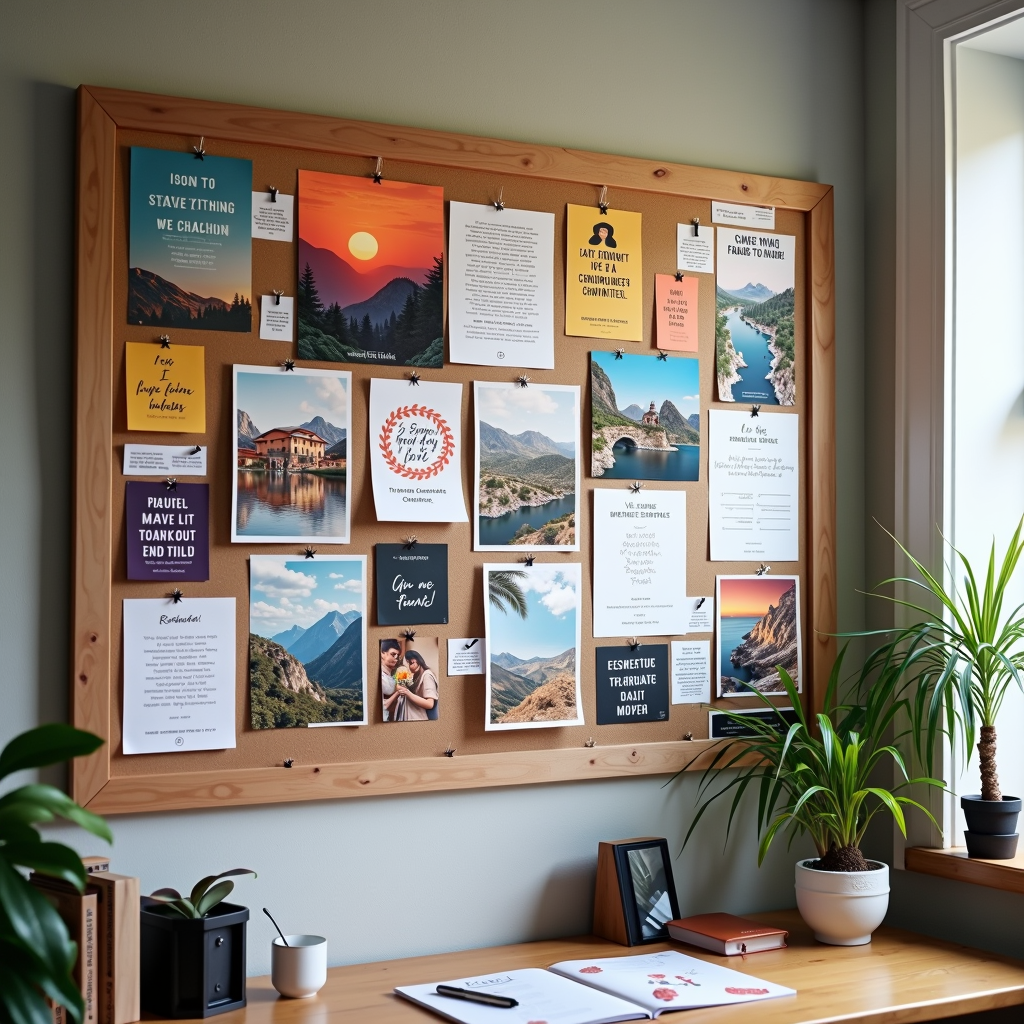How to Manifest Happiness in Your Life
Manifestation is the art of turning your thoughts into reality. Like a cosmic vending machine, but instead of snacks, you’re ordering up a slice of happiness.
Think it, feel it, live it. That’s the gist. Your brain is a powerful tool, and manifestation is all about using it. Imagine happiness, and boom—you’re on your way to feeling it.
“As a man thinketh in his heart, so is he.” – Proverbs 23:7
Sounds easy, right? Well, it’s not rocket science, but it’s not exactly a walk in the park either. It takes practice, persistence, and a dash of belief. But hey, if you can manifest a parking spot, why not happiness?
The psychology behind happiness
Happiness isn’t just rainbows and unicorns. It’s a complex cocktail of brain chemicals, life experiences, and genetic predisposition. Dopamine, serotonin, oxytocin – these are the real MVPs of your mood.
Your brain’s like a happiness factory. Feed it the right ingredients – positive thoughts, gratitude, social connections – and it’ll churn out bliss like there’s no tomorrow. Neglect it, and you’re in for a gloomy ride.
In a 2005 study, researchers found that 50% of happiness is determined by genes, 10% by circumstances, and 40% by intentional activities.
The kicker? You’ve got more control over your happiness than you might think. It’s not about waiting for good things to happen. It’s about training your brain to see the good in what’s already there.

Why manifesting happiness is important
Why bother manifesting happiness? Well, why breathe? Happiness isn’t just a nice-to-have, it’s essential. It’s the secret sauce that makes life worth living.
Happy people live longer, have better relationships, and are more successful. They’re like human sunshine, brightening up everything around them. Who wouldn’t want a piece of that action?
Ancient Greek philosopher Aristotle believed that happiness was the meaning and purpose of life, the whole aim and end of human existence.
But here’s the real kicker – happiness is contagious. When you manifest it, you’re not just doing yourself a favor. You’re spreading joy like a viral cat video. So go ahead, manifest away. The world could use a little more happiness.
Read: How to Manifest Friends: Practical Tips for Building Meaningful Connections
The Science of Happiness
Neurochemistry and happiness
Your brain’s a chemical playground. Dopamine, serotonin, oxytocin – these aren’t just fancy words. They’re your happiness squad, working overtime to keep you grinning.
Dopamine’s your reward guy. It’s that rush you get when you nail a presentation or score a date. Serotonin? The mood stabilizer. It’s keeping you from going bonkers when life throws curveballs.
In 1935, scientists accidentally discovered serotonin while studying blood pressure. Talk about a happy accident!
Oxytocin’s the cuddle hormone. It’s what makes you feel all warm and fuzzy after a hug. Your brain’s basically a drug dealer, but instead of street cred, it’s peddling pure joy.
The role of genetics in happiness
Blame your parents for your mood swings. Genetics play a big role in your happiness levels. Some people hit the DNA jackpot and are naturally cheery. Others? Not so much.
But don’t throw in the towel just yet. Your genes aren’t the boss of you. They’re more like guidelines. You’ve got the power to override your genetic predisposition.
A 2016 study found that the gene SLC6A4 plays a crucial role in happiness. It’s like your personal happiness switch.
So what if you didn’t win the genetic lottery? You can still train your brain to be happier. It’s like going to the gym, but for your mood. No sweat, just smiles.
Environmental factors influencing happiness
Your surroundings matter. A lot. Living in a war zone? Probably not great for your happiness levels. Chilling on a beach? Now we’re talking.
But it’s not just about where you live. It’s about who you’re with, what you do, and how you spend your time. Your environment shapes you, whether you like it or not.
“Men are disturbed not by things, but by the views which they take of them.” – Epictetus
The good news? You’re not stuck. Don’t like your environment? Change it. Can’t change it? Change how you see it. Your perception is your reality. Make it a happy one.
Mindset Shifts for Manifesting Happiness
Cultivating a positive outlook
Positivity isn’t just for Pollyanna. It’s a superpower. Your brain’s like a sponge, soaking up whatever you feed it. So why not serve it a heaping helping of optimism?
Negative thoughts? Kick ’em to the curb. Replace “I can’t” with “I’ll figure it out”. It’s not about ignoring problems. It’s about facing them head-on with a can-do attitude.
In a 1998 study, nuns who expressed more positive emotions in their autobiographies lived up to 10 years longer than their less cheery sisters.
Positive thinking isn’t magic. It’s a habit. Like brushing your teeth, but for your brain. Do it daily, and watch your life transform. No wand required.
Read: How to Attract Venus: Top Strategies for Success

Embracing gratitude
Gratitude isn’t just for Thanksgiving. It’s a year-round gig. Count your blessings, not your problems. You’ll be surprised how much good stuff you’ve got going on.
Keep a gratitude journal. Write down three good things daily. Lost your job? At least you’ve got time to binge-watch that new series. Car broke down? Hey, free cardio!
“Gratitude turns what we have into enough.” – Aesop
Gratitude’s like a happiness booster shot. It rewires your brain to focus on the positive. And the best part? It’s free. No prescription needed.
Letting go of limiting beliefs
Your mind’s full of junk. Time for a spring cleaning. Those limiting beliefs? They’re just stories you tell yourself. And newsflash: most of them are fiction.
“I’m not good enough.” Says who? “I’ll never be happy.” Not with that attitude, you won’t. These thoughts are like clingy exes. It’s time to break up with them.
In 1954, Roger Bannister broke the four-minute mile, a feat previously thought impossible. Within a year, 16 other runners did the same.
Challenge those beliefs. Question them. Prove them wrong. Your potential’s only limited by your imagination. So dream big, and watch those limits crumble.
The Power of Visualization
Creating a mental image of happiness
Close your eyes. Picture happiness. What do you see? A tropical beach? A pile of cash? Your ex crying? Whatever floats your boat. Mental imagery isn’t just daydreaming. It’s a powerful tool for manifesting happiness.
Your brain can’t tell the difference between real and imagined experiences. So when you visualize happiness, your brain starts producing those feel-good chemicals. It’s like tricking your brain into being happy. Sneaky, huh?
In 1995, researchers found that mental practice alone improved piano performance almost as much as physical practice.
The more vivid your mental image, the better. Add details. Smells, sounds, textures. Make it so real you can almost taste it. Your brain will lap it up like a thirsty dog.
Read: How to Manifest a Job in 24 Hours Especially When You Need It
Using vision boards effectively
Vision boards. They’re not just for arts and crafts enthusiasts. They’re a powerful visualization tool. Think of it as a physical representation of your mental happy place.
Slap some pictures on a board. Your dream job. Your ideal body. That yacht you’ve been eyeing. Make it a collage of your happiest life. Hang it where you’ll see it daily. It’s like a constant reminder to your brain of what you’re working towards.
Oprah Winfrey swears by vision boards. She created one in 1985 that included an image of her starring in a major film. Three years later, she was nominated for an Oscar for her role in “The Color Purple”.
Don’t just set it and forget it. Engage with your vision board. Add to it. Update it. Let it evolve as your dreams do. It’s not a static piece of art. It’s a living, breathing representation of your happiness goals.
Incorporating all senses in visualization
Visual imagery is great, but why stop there? Your brain’s got five senses. Use ’em all. It’s like giving your brain a full-sensory happiness buffet.
Imagine the sound of waves crashing on your dream beach. The smell of success (whatever that smells like to you). The taste of victory. The feel of that designer outfit against your skin. The more senses you involve, the more real it feels to your brain.
A 2009 study found that Olympic athletes who used multi-sensory imagery performed better than those who only used visual imagery.
Don’t just see your happy future. Hear it. Smell it. Taste it. Feel it. Make it so real in your mind that your brain has no choice but to believe it’s true. That’s when the magic happens.
Remember, visualization isn’t about escaping reality. It’s about creating a blueprint for your brain to follow. So make it good. Make it detailed. And most importantly, make it happy. Your brain will thank you for it.

Affirmations and Positive Self-Talk
Crafting effective affirmations
Affirmations. They’re not just feel-good mumbo jumbo. They’re your brain’s personal cheerleaders. Short, snappy, and positive statements that pack a punch.
Keep ’em simple. “I am worthy.” “I attract happiness.” “I’ve got this.” The more you repeat them, the more your brain buys into them. It’s like brainwashing, but in a good way.
In 1920, Émile Coué coined the famous affirmation, “Every day, in every way, I’m getting better and better.” Talk about optimism!
Make your affirmations personal. Tailor them to your needs. Want more confidence? “I am confident and capable.” Boom. You’re halfway there.
Read: How to Manifest a Boyfriend (Without Going Crazy!)
Incorporating affirmations into daily routines
Don’t just save affirmations for special occasions. Make them part of your daily grind. Brush your teeth, say an affirmation. Get dressed, say an affirmation. It’s like multitasking for your mood.
Stick Post-its with affirmations on your mirror. Set them as phone reminders. Tattoo them on your forehead. Okay, maybe not that last one. But you get the idea. The more you see them, the more they sink in.
A 2015 study found that self-affirmation can boost problem-solving abilities under stress. Who knew positive self-talk could make you smarter?
Repeat your affirmations out loud. Your brain’s not just a reader, it’s a listener too. Plus, it’s a great way to drown out that annoying coworker. Win-win.
Overcoming negative self-talk
Your inner critic’s a jerk. Time to shut it up. Every time you catch yourself thinking something negative, flip it on its head. “I’m a failure” becomes “I’m learning and growing.”
Don’t just ignore negative thoughts. Challenge them. Ask for evidence. “I’m worthless?” Really? Where’s the proof? Chances are, your inner critic’s all talk and no substance.
“The mind is everything. What you think you become.” – Buddha
Practice self-compassion. Talk to yourself like you’d talk to a friend. You wouldn’t call your bestie a loser, would you? So why do it to yourself? Be your own BFF. Your brain will thank you for it.
Remember, your thoughts shape your reality. So make them good ones. Positive self-talk isn’t just about feeling good. It’s about creating the life you want. One affirmation at a time.
Practicing Mindfulness and Meditation
Different mindfulness techniques
Mindfulness. It’s not just for hippies anymore. It’s the art of being present. Like time travel, but instead of the future, you’re zapping yourself into the now.
There’s a buffet of techniques to choose from. Body scan? Feel every inch of yourself without moving. Breathing exercises? Count those inhales and exhales like they’re winning lottery numbers.
In 1979, Jon Kabat-Zinn founded the Mindfulness-Based Stress Reduction program, bringing mindfulness into mainstream medicine.
Loving-kindness meditation? It’s like sending mental hugs to everyone, even that guy who cut you off in traffic. Mindful eating? Savor every bite like it’s your last meal. Your taste buds will thank you.
Read: How to Manifest Your Dream Life: Proven Strategies for Success
The benefits of regular meditation
Meditation’s not just om-ing your way to inner peace. It’s a brain workout. It beefs up your gray matter like spinach beefed up Popeye.
Stress? Melts away faster than ice cream on a hot day. Anxiety? Takes a hike. Focus? Sharpens like a ninja’s blade. Sleep? Deeper than a philosopher’s thoughts.
A 2011 Harvard study found that meditation can actually change the structure of the brain, increasing gray matter in areas associated with learning and memory.
Blood pressure drops. Immune system revs up. Creativity blooms. It’s like a miracle drug, but without the nasty side effects. And the best part? It’s free. No prescription needed.
Integrating mindfulness into everyday life
Mindfulness isn’t just for the meditation cushion. It’s an all-day, everyday affair. Washing dishes? Feel the warm water, smell the soap. Stuck in traffic? Perfect time for a breathing exercise.
Eating lunch? Taste every flavor. Walking? Feel each step. It’s about turning off autopilot and tuning into the present moment. Life’s too short for zombieing through it.
“The present moment is the only time over which we have dominion.” – Thích Nhất Hạnh
Start small. One mindful minute a day. Then two. Then five. Before you know it, you’re a mindfulness ninja, slicing through stress and dicing up worries. Your mind will be as cool as a cucumber in a snowstorm.
Remember, mindfulness isn’t about emptying your mind. It’s about noticing your thoughts without getting caught up in them. Like watching clouds pass by in the sky. You’re not the clouds, you’re the sky. And the sky is always calm, no matter what’s floating through it.
Building and Nurturing Relationships
The importance of social connections
Humans are social creatures. We need connections like plants need sunlight. Without them, we wither. Loneliness? It’s a silent killer, more dangerous than obesity or smoking.
Strong relationships boost happiness levels faster than a shot of espresso. They’re your personal cheerleading squad, support system, and reality check all rolled into one.
A Harvard study spanning 80 years found that good relationships are the best predictor of long-term happiness and health.
Social connections aren’t just nice to have. They’re essential. They reduce stress, boost self-esteem, and even strengthen your immune system. It’s like friendship is the ultimate superfood.
Read: How to Manifest Overnight & Achieve Your Goals Quickly
Cultivating empathy and compassion
Empathy and compassion. They’re not just for saints and therapists. They’re relationship superglues. Understanding others’ feelings and wanting to help? That’s the good stuff.
Practice putting yourself in others’ shoes. It’s not about agreeing with everyone. It’s about understanding where they’re coming from. Even if where they’re coming from is Crazytown.
The Dalai Lama once said, “If you want others to be happy, practice compassion. If you want to be happy, practice compassion.”
Compassion isn’t just good for others. It’s good for you too. It reduces stress, boosts happiness, and makes you feel all warm and fuzzy inside. It’s like a hug for your soul.
Setting healthy boundaries in relationships
Boundaries. They’re not walls. They’re fences with gates. They keep the bad stuff out and let the good stuff in. Without them, you’re a doormat with a pulse.
Learn to say no. It’s not selfish, it’s self-care. You can’t pour from an empty cup. Fill yours first, then help others. It’s like the airplane oxygen mask rule, but for life.
In 1988, psychologists Henry Cloud and John Townsend popularized the concept of personal boundaries in their book “Boundaries: When to Say Yes, How to Say No to Take Control of Your Life”.
Healthy boundaries create respect. They show others how to treat you. No mind reading required. Clear communication is key. Tell people what you need. They’re not psychic.
Remember, relationships are a two-way street. Give and take. Support and be supported. It’s not a competition, it’s a collaboration. Together, you’re stronger than the sum of your parts.
Pursuing Personal Growth and Self-Improvement
Identifying areas for personal development
Self-improvement isn’t a one-size-fits-all deal. It’s as unique as your fingerprint. Take a good, hard look in the mirror. What needs work? Your temper? Your waistline? Your ability to adult?
Be honest with yourself. Brutally honest. Like, “I can’t believe I just said that out loud” honest. That’s where the real growth happens.
Benjamin Franklin had a daily routine where he asked himself, “What good shall I do this day?” and “What good have I done today?” Talk about self-reflection!
Grab a pen. Make a list. Prioritize. You can’t fix everything at once. Unless you’re Superman. And if you are, why are you reading this? Go save the world or something.
Setting and achieving meaningful goals
Goals. They’re not just for soccer players. They’re your personal roadmap to awesomeness. But not all goals are created equal. “Get rich” is vague. “Save $10,000 this year” is specific. And achievable. Unless you’re really into avocado toast.
Break big goals into smaller steps. It’s like eating an elephant. One bite at a time. Not that you should eat elephants. That’s just weird.
In 1979, a Harvard study found that the 3% of graduates who had written goals were earning, on average, ten times as much as the other 97% combined.
Write your goals down. Stick them on your fridge. Tattoo them on your forehead. Okay, maybe not that last one. But make them visible. Your brain needs constant reminders. It’s forgetful like that.
Read: Effective Techniques and Tips on How to Manifest with Water
Embracing lifelong learning
Learning doesn’t stop when you toss that graduation cap. That’s when the real education begins. Your brain’s like a muscle. Use it or lose it. And trust me, you don’t want to lose it. It’s kind of important.
Read books. Take classes. Learn a new skill. Heck, learn to juggle flaming torches if that’s your thing. Just keep that gray matter active.
Michelangelo, at the ripe old age of 87, said, “I am still learning.” If it’s good enough for the guy who painted the Sistine Chapel, it’s good enough for you.
Be curious. Ask questions. Challenge assumptions. Including your own. Especially your own. The moment you think you know everything is the moment you stop growing. And that’s just sad.
Remember, personal growth isn’t a destination. It’s a journey. A lifelong journey. So pack your bags, grab your curiosity, and hit the road. Your future self will thank you for it. Probably with a really cool handshake they learned on YouTube.
Physical Well-being and Happiness
The mind-body connection
Your body and mind aren’t just roommates. They’re besties. What happens to one affects the other. It’s like they’re in a co-dependent relationship, but in a good way.
Feeling down? Your body slouches. Feeling great? You’ve got a spring in your step. It’s not rocket science, it’s biology. Your thoughts and emotions aren’t just in your head. They’re in every cell of your body.
Ancient Greek physician Hippocrates said, “The natural healing force within each one of us is the greatest force in getting well.”
Stress isn’t just mental. It’s physical too. It can mess with your digestion, weaken your immune system, and even make your hair fall out. Talk about a bad hair day.
Exercise and its impact on mood
Exercise isn’t just for gym rats and fitness freaks. It’s nature’s antidepressant. A jog around the block can boost your mood faster than you can say “endorphins”.
You don’t need to run a marathon or bench press a car. A brisk walk, a dance party in your living room, or even some vigorous housecleaning can do the trick. Your body doesn’t care what you do, as long as you move it.
In a 1999 study, researchers found that exercise was just as effective as medication in treating depression in some people.
Regular exercise can reduce anxiety, improve sleep, and boost self-esteem. It’s like a happiness trifecta. Plus, you might end up with abs. Bonus!
Read: Can I Manifest Two Things at the Same Time?
Nutrition and its role in emotional well-being
You are what you eat. And if you’re eating junk, well… Nutrition isn’t just about your waistline. It’s about your mental health too. Your brain’s like a picky toddler. Feed it right, and it’ll behave. Feed it crap, and you’re in for a tantrum.
Omega-3s, B vitamins, and antioxidants aren’t just fancy words on supplement bottles. They’re brain food. They help fight depression, reduce anxiety, and improve mood. It’s like Prozac, but tastier.
A 2017 study found that people who ate a Mediterranean-style diet had a 33% lower risk of developing depression.
Ditch the processed junk. Embrace whole foods. Your brain (and your taste buds) will thank you. And remember, chocolate’s a vegetable. Dark chocolate, that is. It’s practically health food.
Physical well-being isn’t just about looking good in a swimsuit. It’s about feeling good in your own skin. It’s about giving your brain the tools it needs to be happy. So move your body, feed it right, and watch your mood soar. It’s not magic, it’s science. Delicious, mood-boosting science.
Creating a Positive Environment
Decluttering and organizing your space
Time for a spring cleaning! Your surroundings affect your mood more than you think. A messy space equals a messy mind. So grab those trash bags and get to work.
Start small. One drawer, one shelf, one room at a time. It’s not a race. Unless you want it to be. In which case, ready, set, declutter!
Marie Kondo, the organizing guru, says, “The space in which we live should be for the person we are becoming now, not for the person we were in the past.”
Organize with purpose. Everything should have a home. No more “junk drawers” or “I’ll deal with it later” piles. Your future self will thank you.

Surrounding yourself with uplifting people
You’re the average of the five people you spend the most time with. So choose wisely. Negative nellies? Show ’em the door. Energy vampires? Grab the garlic.
Seek out positive peeps. The ones who lift you up, not drag you down. They’re like human Red Bulls, minus the jitters and weird aftertaste.
Jim Rohn, entrepreneur and motivational speaker, famously said, “You are the average of the five people you spend the most time with.”
Don’t just collect friends like Pokemon. Quality over quantity. One true friend is worth a thousand acquaintances. Unless those acquaintances are giving away free pizza. Then all bets are off.
Incorporating nature and natural elements
Nature’s not just for hippies and bear Grylls wannabes. It’s a mood booster on steroids. Can’t go outside? Bring the outside in. Plants, people. They’re not just for eating anymore.
Natural light? It’s your new best friend. Open those curtains. Let the sunshine in. Vitamin D isn’t just for milk cartons. It’s nature’s happy pill.
A 2019 study found that spending just 20 minutes in nature significantly lowered stress hormone levels.
Add natural elements to your decor. Wooden furniture, stone accents, water features. It’s like turning your home into a spa, minus the awkward robes and cucumber water.
Remember, your environment shapes you. So shape it first. Make it a reflection of the happy, positive person you want to be. Even if that means putting a plant on every available surface. Hey, if it works, it works.
Read: How to Manifest Good Health for Someone Else
Cultivating Resilience and Emotional Intelligence
Developing coping mechanisms for stress
Stress. It’s like that uninvited guest who overstays their welcome. But you don’t have to let it crash on your couch forever. Time to kick it to the curb.
Deep breathing? It’s not just for yoga nuts. It’s your secret weapon against stress. Inhale calm, exhale chaos. Repeat as needed.
In the 1970s, Dr. Herbert Benson discovered the “relaxation response,” showing that simple techniques like deep breathing could counteract the stress response.
Exercise is stress’s kryptonite. Punch a punching bag. Run like you’re being chased by a bear. Dance like nobody’s watching (even if they are). Sweat it out, and watch your worries melt away.
Learning from setbacks and failures
Failures aren’t dead ends. They’re detours. Rerouting you to something better. So your brilliant plan flopped? Congrats! You’ve just discovered one way that doesn’t work.
Analyze your failures. What went wrong? What can you do differently next time? It’s like being a detective, but the crime scene is your life choices.
Thomas Edison famously said, “I have not failed. I’ve just found 10,000 ways that won’t work.” That’s some next-level optimism right there.
Resilience isn’t about never falling. It’s about getting back up every time you do. So dust yourself off, learn your lesson, and get back in the game. Your comeback story is waiting to be written.
Enhancing emotional awareness and regulation
Emotions. They’re like toddlers. Ignore them, and they’ll throw a tantrum. Acknowledge them, and they’ll calm down. Time to become the emotion whisperer.
Label your feelings. “I’m angry.” “I’m anxious.” “I’m hangry.” Naming them takes away their power. It’s like emotional kryptonite.
In the 1990s, psychologist Daniel Goleman popularized the concept of emotional intelligence, showing it’s just as important as IQ for success in life.
Practice mindfulness. Notice your emotions without judging them. They’re not good or bad. They just are. Like weather patterns in your mind. Stormy today, sunny tomorrow.
Emotional intelligence isn’t about suppressing feelings. It’s about understanding and managing them. So feel all the feels. Just don’t let them drive the car. You’re the driver, they’re the passengers. Keep them in check, but don’t kick them out. They make the journey interesting.

The Role of Purpose and Meaning
Discovering your life’s purpose
Life’s purpose. It’s not hiding in your sock drawer. It’s not at the bottom of a pint of ice cream. It’s in you. Always has been. You just need to uncover it.
Start with what lights you up. What makes you lose track of time? That’s your purpose waving its arms, screaming, “Hey! Over here!”
Viktor Frankl, Holocaust survivor and psychiatrist, wrote, “Life is never made unbearable by circumstances, but only by lack of meaning and purpose.”
Don’t wait for a lightning bolt of inspiration. Purpose is more like a dimmer switch. It gets brighter with use. So start using it already.
Read: How to Manifest Divorce
Aligning actions with personal values
Values aren’t just for Fortune 500 companies. They’re your personal GPS. When your actions match your values, life feels like a smooth ride. When they don’t? It’s like driving with the parking brake on.
List your values. Honesty? Kindness? Taco Tuesdays? No judgment here. Then check if your daily actions line up. If not, time for a course correction.
Mahatma Gandhi said, “Happiness is when what you think, what you say, and what you do are in harmony.”
Living your values isn’t always easy. Sometimes it means saying no to good things to say yes to great things. It’s like being on a diet and passing up the donut for the six-pack abs. Short-term pain, long-term gain.
Contributing to something greater than yourself
Want to feel truly alive? Contribute to something bigger than your Twitter following. It’s not about changing the world. It’s about changing someone’s world.
Volunteer. Donate. Help a stranger. Heck, just hold the door open for someone. Small acts add up. It’s like compound interest for your soul.
Anne Frank wrote in her diary, “How wonderful it is that nobody need wait a single moment before starting to improve the world.”
Contributing isn’t just good for others. It’s good for you too. It boosts happiness, reduces stress, and gives life meaning. It’s like a happiness hack, but legal and without the side effects.
Remember, you’re not just a passenger in this life. You’re the driver. So grab the wheel, set your course, and make your mark. The world’s waiting. And it could use a little more of whatever you’ve got to give.
Practicing Gratitude and Appreciation
Keeping a gratitude journal
Gratitude journals. They’re not just for hipsters and self-help gurus. They’re your personal happiness bank. Deposit good vibes daily, withdraw joy whenever you need it.
Start small. Three things you’re grateful for each day. Your comfy bed. That killer sandwich you had for lunch. The fact that your cat didn’t barf on the carpet today. It all counts.
In a 2003 study, participants who kept gratitude journals for 10 weeks reported feeling 25% happier than those who didn’t. That’s a lot of happy for a little scribbling.
Be specific. “I’m grateful for my family” is nice. “I’m grateful my sister didn’t kill me when I borrowed her favorite shirt without asking” is better. Details make it real.
Expressing appreciation to others
Appreciation. It’s not just for employee of the month plaques. It’s a superpower. Use it wisely and often. Tell people what you appreciate about them. Be specific. Be sincere.
Don’t save it for special occasions. Appreciate the barista who makes your coffee. The bus driver who gets you to work. The coworker who didn’t steal your lunch from the office fridge.
William James, the father of American psychology, said, “The deepest principle in human nature is the craving to be appreciated.”
Write thank-you notes. Not emails. Actual, handwritten notes. On paper. With a pen. Remember those? They’re like text messages, but classier and without emojis.

Finding joy in small moments
Joy isn’t just for big events. It’s hiding in plain sight. In your morning coffee. In the sun on your face. In that perfect parallel parking job you just nailed. Seek it out. Savor it.
Practice mindfulness. Notice the little things. The texture of your food. The sound of laughter. The feel of warm laundry fresh from the dryer. It’s like a scavenger hunt for happiness.
Thích Nhất Hạnh, Buddhist monk and peace activist, said, “The present moment is filled with joy and happiness. If you are attentive, you will see it.”
Create joy rituals. A dance party while brushing your teeth. A victory lap around your living room after finishing a task. A happy dance when you find money in your pocket. Life’s too short not to celebrate the small stuff.
Remember, happiness isn’t a destination. It’s a collection of moments. So collect them like they’re going out of style. String them together like the world’s happiest necklace. Wear it proudly. You’ve earned it.
Balancing Work and Personal Life
Setting priorities and managing time effectively
Work-life balance. It’s not just a buzzword. It’s the holy grail of modern life. And like any treasure, it takes some digging to find.
Start by prioritizing. Not everything’s urgent. Not everything’s important. Learn to tell the difference. It’s like sorting your laundry, but for your life.
Benjamin Franklin once said, “By failing to prepare, you are preparing to fail.” Old Ben knew his stuff.
Time management isn’t about cramming more into your day. It’s about making room for what matters. Use tools. Calendars, to-do lists, alarms. Whatever keeps you on track.
Creating boundaries between work and personal life
Boundaries. They’re not just for countries. Your work life and personal life need them too. Without them, work bleeds into everything like a leaky pen in your pocket.
Set office hours. Even if you work from home. When work time’s over, it’s over. No checking emails at 3 am. Unless you’re expecting a million-dollar offer. Then maybe.
A 2018 study found that employees who set clear boundaries between work and personal life reported higher job satisfaction and lower burnout rates.
Create physical boundaries too. A dedicated workspace. Even if it’s just a corner of your living room. When you’re there, you’re at work. When you’re not, you’re off the clock.
Finding fulfillment in your career
Work shouldn’t feel like a prison sentence. If it does, it’s time for a jailbreak. Find what lights you up. What makes Monday mornings exciting, not dreadful.
Set career goals. Not just “make more money.” Real, meaningful goals. What impact do you want to make? What skills do you want to develop? It’s like creating a bucket list, but for your career.
Confucius said, “Choose a job you love, and you will never have to work a day in your life.” Wise words from a guy who lived over 2,500 years ago.
Seek growth opportunities. Take on new challenges. Learn new skills. It’s like fertilizer for your career. Feed it, and watch it grow.
Remember, balance isn’t about perfect equilibrium. It’s about finding a rhythm that works for you. Some days work wins. Some days life does. It’s okay. As long as over time, you’re moving in the right direction. Towards a life that’s fulfilling both in and out of the office.
Embracing Creativity and Self-Expression
Exploring different forms of creative outlets
Creativity isn’t just for artsy types. It’s for everyone. Got hands? You can create. Got a brain? You can innovate. It’s time to unleash your inner Picasso, even if your stick figures look like they’ve been in a car accident.
Try different things. Painting, writing, interpretive dance in your living room. Don’t limit yourself. Your creative outlet might be cooking, coding, or even creative insults. Hey, it’s still art.
Pablo Picasso said, “Every child is an artist. The problem is how to remain an artist once we grow up.” Well, it’s time to channel your inner child. Finger paints optional.
Don’t worry about being good. Just focus on enjoying the process. You’re not trying to get into the Louvre. Unless you are. In which case, maybe stick to traditional mediums. They’re not big on macaroni art.

Using art and creativity for emotional release
Art therapy isn’t just for people who can afford fancy therapists. It’s DIY emotional release. Angry? Splatter paint like Jackson Pollock. Sad? Write a poem that would make emo kids weep.
Your art doesn’t have to make sense to anyone but you. It’s your emotional garbage disposal. Throw all your feelings in there and watch them get chewed up and spit out as something beautiful. Or at least interesting.
Psychologist Mihaly Csikszentmihalyi found that people are happiest when they’re in a state of flow, often achieved through creative activities.
Don’t censor yourself. Let it all out. Your art journal is like Vegas. What happens there, stays there. Unless you decide to share it. Then it’s more like Instagram. Filter at your own discretion.
Incorporating play and fun into daily life
Adulting is overrated. It’s time to bring back playtime. Remember recess? That, but for grown-ups. Without the awkward puberty stuff.
Dance while doing chores. Have a nerf gun war in the office. Turn your commute into a secret spy mission. Life’s too short to be serious all the time.
George Bernard Shaw said, “We don’t stop playing because we grow old; we grow old because we stop playing.” So play on, you eternal child, you.
Make boring tasks fun. Grocery shopping becomes a scavenger hunt. Mowing the lawn becomes a race against time. Doing taxes becomes… okay, maybe some things are beyond help. But you get the idea.
Creativity and play aren’t luxury items. They’re essential. Like oxygen, but more fun. They’re your secret weapons against stress, boredom, and the general suckiness of adulting. So go forth and create. Play like your happiness depends on it. Because, spoiler alert: it kind of does.


